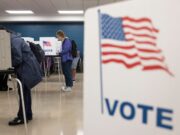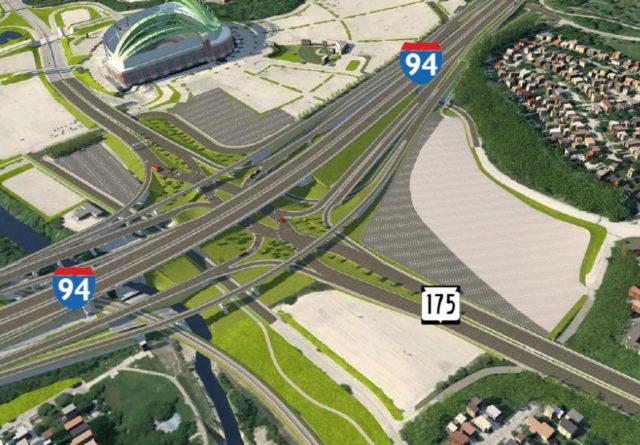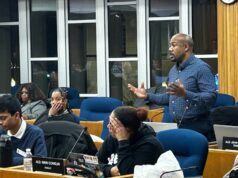On Monday, a group of protesters waited outside the Tommy Thompson Youth Center in Milwaukee. They held signs that read, “More transportation now,” and “#FixatSix.” These protestors were waiting for the first of two scheduled public hearings on the proposed expansion of parts of Milwaukee’s I-94 highway.
In mid November, the state Department of Transportation announced plans to not only reconstruct a section of I-94 that spans from American Family Field to Marquette University, but to add an additional lane on each side, expanding the highway from six lanes to eight.
Public opposition has grown since that announcement, with local advocacy groups asking that the DOT instead adopt a plan they call “Fix at Six” which would reconstruct the highway, but leave it at the current six lanes, lowering the amount of construction time and community disruption.
When asked in an interview about the reasoning behind adding two more lanes, DOT officials pointed to “congestion-related safety issues,” such as swerving and rear-ending.” They believe that at six lanes, the corridor “would remain significantly congested.” In another statement, they reference the proposed costs of each project, noting that reconstructing and expanding to eight lanes would cost $1.2 billion, as opposed to a six-lane reconstruction which would cost $1.13 billion.
For community members and advocates however, the difference between the “fix at six” and the proposed eight lanes is more than a cost analysis issue.
Cassie Steiner, Senior Campaign Coordinator with the Wisconsin Chapter of the Sierra Club, worries about the effect of the expansion on communities of color.
“The highway system’s creation helped solidify racial segregation. Further expanding a physical barrier between Black neighborhoods and white neighborhoods adds to this problem,” she said in an interview.
She also noted how the project would cause undue harm to specific communities, like that of Piggsville, a majority African American community located near American Family Field, where the Milwaukee Brewers play. The neighborhood, which already struggles with being a near food desert, would lose some access to one of its only green spaces, Valley Park, due to the proposed expansion. In an Op-Ed for Urban Milwaukee, Piggsville resident Leland Pan explains that, “the expansion would demolish [the only accessible grocery store in the area], an urgent care center, and a Black owned bar on N. 35th St.”
Another issue presented by advocates is the environmental effects caused by the project. Though the DOT has said they are conducting an “ongoing environmental analysis” in relation to the proposed expansion, advocates see clearly the negative effects it will have on the surrounding communities. The construction associated with the project would increase air pollution and runoff of toxic materials into the river system, which can lead to health consequences for those who live in the area or access that water source.
Gregg May, Director of Transportation Policy for the environmental advocacy organization 1000 Friends of Wisconsin, says that his organization calls this kind of proposal “irresponsible” in the face of the latest data about climate change.
Through the governor’s Climate Change task force, created in 2019, states and cities have proposed ambitious goals to help curb greenhouse gas emissions and lessen the effects of climate change. However the amount of environmental hazards created by this project would endanger the completion of those goals. The climate task force itself referred to highways as “environmentally harmful infrastructure” in its report released in December 2020. Despite this, it was Governor Evers Office that decided to fast track the funding for this project, which had originally been paused indefinitely in 2016 under the Walker administration.
“Transportation is the largest contributor to climate change in the United States. Individual cars make up about 60% of those emissions,” May told Madison365, adding hat expanding the highway would only encourage more individual drivers to take to the road, which would increase emissions and congestion.
In fact, a 2007 report by Sightline Institute found that adding just one mile of new highway lane will lead to 100,000 tons of carbon emissions over the course of the following 50 years. It goes on to note that this level of emissions equals roughly the 50-year carbon footprint of 100 US residents.
Multiple organizations have noted that this proposal also comes at a time when public transportation is at risk in Milwaukee County. By 2025 the county’s transit system will have a total budget deficit of 40 Million dollars, according to WPR, and the system has been running with a budget deficit for the past three years alone. Cuts have already been made to transportation services, like the shutting down of bus routes in the city, the discontinuation of shuttles to the ethnic festivals and summerfest. This deficiency would mean the elimination of the freeway flyer service and reduce frequency on several bus routes.
Supervisor Peter Burgelis, representative for Milwaukee’s 16th district said in a statement, “Building oversized freeways without considerations for multimodal transportation or permanent transit infrastructure is narrow-minded and shortsighted.”
This loss of public transit resources will directly affect communities of color, according to Steiner. “Communities of Color have higher rates of transit dependency and lower rates of car ownership than white communities in the area,” She says, meaning that as public transit resources dwindle in favor of large highways these communities will be left out and unable to commute to buy food, see family, or go to work. She notes that the choice to expand the highway instead of public transit services is an, ”intentional choice by WISDOT to prioritize drivers (especially white suburban drivers) over transit users.”
Organizations like the ACLU of Wisconsin, 1000 Friends of Wisconsin, Milwaukee Riverkeepers and the Sierra Club all point to the “Fix at Six” proposal as a solution.
This alternative would address the current safety concerns of the area, but instead of adding more lanes, those funds would be allocated to “more pressing” issues such as road repairs and transportation infrastructure. Part of the transportation infrastructure this plan proposes includes creating a new bus rapid transit line between National and Greenfield Avenue, and promoting walkable and bikeable neighborhoods in Milwaukee. It also includes calls to revitalize neighborhoods and green spaces damaged by the original construction of the highway.
Importantly the Fix at Six plan is not the same as the DOT’s original six lane repair proposal. Fix at Six includes what advocates believe are the desires of the community, in terms of expanding public transportation, addressing environmental issues with the project and remediating issues caused by the highway’s original construction, all of which are not included in either of the DOT plans.
In an interview, the DOT said that they have heard Fix at Six advocates loud and clear. They mentioned that due to the efforts of advocates changes have been made to the plan, including, down scoping the stadium interchange into a diamond configuration so that veterans graves and real estate holdings are not damaged. They added that, “A notable outcome from our outreach with the public on the I-94 East-West project includes the department’s commitment to conducting a study that will reexamine solutions for the reconstruction of WIS 175.”
On Wednesday, another public hearing was held so that the public could give comments on the proposal. The comment period ends in mid January, at which time the DOT will release a final evaluation and decision on the project. According to the DOT’s estimates, construction will begin in 2025 and end by 2029.

































